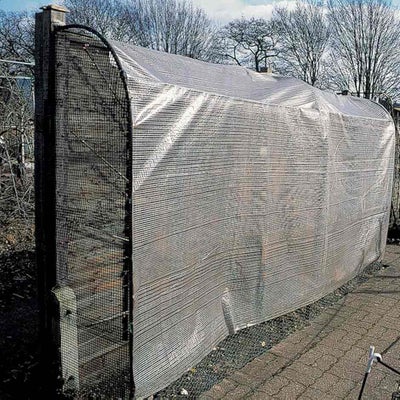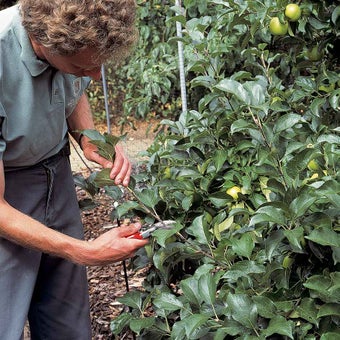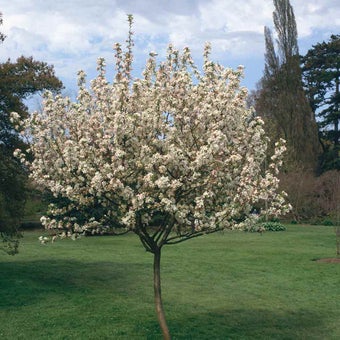
Quick facts
Suitable for - Apples, pears and other top fruit and soft fruit.
Timing - Late winter through spring
Difficulty - Moderate
Suitable for...
Most soft fruit and top fruit, with the exception of figs, are very hardy while over the winter as temperatures do not fall low enough to harm these trees in Britain. Gardeners in more severe climates may need to choose cold-resistant rootstocks and cultivars.
However, in early spring, the new growth and blossom can be easily damaged by frost. Not only are plants in full flower vulnerable, but and even fertilised flowers can be damaged, so protection should be maintained for two weeks after flowering if severe frosts threaten.
Frost occurs when temperatures fall below 0ºC (32ºF). On clear nights warmth is radiated out and lost. Cold air forms on trees and other objects and being heavier than warm air sinks to the ground, displacing warm air. Objects near the ground then become chilled and freeze. Cold air naturally flows downward on sloping ground, collecting at the lowest point or against a barrier. If this barrier is a fence or hedge consider creating a gap, or remove some of the lower growth to improve air drainage. If there is no alternative, plant the larger fruit trees at the bottom and the smaller ones on the higher ground.
Wind frosts, where freezing wind blows into the fruit garden, are much less common and usually only affect exposed hill top gardens.
When to protect fruit from frosts
Depending on the fruit, measures may have to be taken to protect vulnerable growth from late winter through spring.
How to protect fruit from frosts
Protection from frost
Most potential fruit damage can be avoided by choosing a site where spring frosts are least likely, but this is seldom an option for gardeners:
- Planting fruit in a sunny, sheltered position such as a south-facing wall – this is especially appropriate for early flowering crops such as apricots, peaches and nectarines
- Avoid frost pockets
If this is not possible consider protecting them with the following methods:
- Soft fruit bushes: use fleece to cover and protect the flowers and developing crop on nights when frost is forecast
- Strawberries: protect with cloches or a double layer of fleece, removing or opening both in the day to allow pollinators access
- Small fruit trees: cover with fleece overnight to provide frost protection and remove during the day, but this is generally impractical with larger trees
- Fruit grown on walls and fences (cordon, espalier or fan-trained): cover with two or three layers of horticultural fleece, hessian or shade netting. This should be rolled up during the day. Use canes to keep the material off the blossoms. Remove the covers as soon as the danger is over
- Keep grass around trees mown short in flowering season, as long grass prevents heat being radiated from the soil
- Apply mulches after flowering – bare soil radiates useful amounts of heat, protecting the blossom
If you are planting in frost-prone gardens choose frost-tolerant cultivars:
- Apples that are late-flowering cultivars include ‘Edward VII’, ‘Crawley Beauty’ and ‘Royal Jubilee’
- Apples with long flowering seasons or frost-resistant blossom include ‘Lane’s Prince Albert’ and ‘Worcester Pearmain’
- Suitable pears are ‘Williams’ Bon Chrétien’ and ‘Onward’
- Frost resistant plums: ‘Pershore’, ‘Czar’ and ‘Blue Tit’
- Acid cherry ‘Morello’ is a traditional, hardy choice
- Raspberries, blackberries and loganberries flower fairly late and are less likely to be damaged although they can be caught by late frosts
- Gooseberries flower after their leaves have formed and are also less likely to be damaged although they too can be nipped by late frosts
- Grow fruit in pots and move to a sheltered position during periods of frost-risk
- Modern blackcurrants have been bred to flower late and avoid frost: `Ben Lomond’, `Ben Tirran'
- Cherries, peaches, nectarines and apricots: small growing cultivars are easier to train on walls and in the case of patio fruit are readily covered in or, if potted, brought under protection on cold nights
Commercial producers use sprinklers and heaters to protect crops, but these need expensive equipment and are most effective when used over large areas – they are seldom appropriate for gardeners.
Problems
Protecting fruits prevents the following problems:
- Spring frosts can destroy new , shoots or flowers
- Plants are often affected in a random pattern, but sometimes only the upper flowers are spared
- Developing may be damaged by cold resulting in heavy russeting and cracking of the skin of apples and pears
- Cold damage may cause malformed fruits, typically on pears







